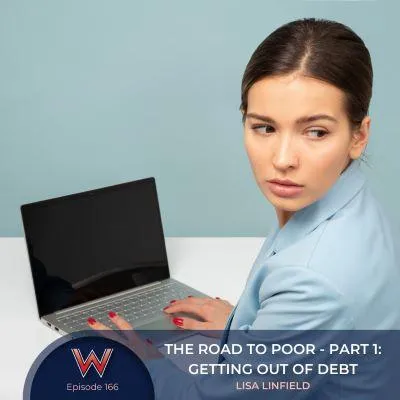Browse for the latest episode of...
working women's wealth

166 The Road to Poor - Part 1: Getting out of debt
Has your debt dug you a hole deeper than you’d planned? Dig yourself free! And make getting out of it a priority this year.
But first, it’s important to understand why being in debt truly IS the Road to Poor, and then you can learn how to minimise the cost of it. In this episode, I discuss ways to do just that.
As Albert Einstein said – “Compound Interest is the eighth wonder of the world. He who understands it, earns it… he who doesn’t, pays it”. And whether negative or positive, It all adds up.
Show notes:
[01.48] The New Year’s Challenge
[03.35] Step 1 – Understanding the cost of debt.
[08.48] Minimising the cost of debt
[10.37] But what about house and car debt?
[12.04] The Road to Poor
Quotes
"As the saying goes, we tend to overestimate what we can achieve in the short term and underestimate what we can do in the long term." - Lisa Linfield
"Let’s be clear, there is no debt that is ‘good’ debt because all of it costs you a huge amount as you pay it off." - Lisa Linfield
Related posts and episodes
How to prevent holiday debt
Subscribe to our podcast on iTunes or Spotify
Please do Subscribe to our Podcast on iTunes or Spotify and leave a review. This helps the podcast to rank higher and therefore makes it more visible to others browsing podcasts in the hope they too may benefit from our content.
Get my book - Deep Grooves: Overcoming Patterns that Keep you Stuck
You can get the first two chapters of my book FREE here
If you want a paperback copy and you’re in South Africa, visit my site LisaLinfield.com
If you want a Kindle copy or a paperback anywhere in the world, visit Amazon
TRANSCRIPT
Hello everyone and welcome to today’s episode of Working Women’s Wealth.
I have just returned from my two week summer vacation – which I know sounds totally odd for those of you in the Northern Hemisphere! I am so grateful for the time off, for rest, relaxation, family and the beauty of one of the unspoilt parts of the coastline of South Africa, the Transkei. It truly is something to sit on your balcony and watch the cows roam on the beach as the sun sets and the waves of the sea role in.
I hope this new year is a great one for you, and that you begin to put in place those daily habits that will change your life – daily money, daily health, daily relationship, daily work habits. It truly is in the little things we do each day where our step change progress lies. As the saying goes, we tend to overestimate what we can achieve in the short term and underestimate what we can do in the long term.
The New Year’s Challenge
One thing that tends to happen in January is that we get back from the holidays in a whole bunch more debt than we planned. Somehow those Christmas presents cost more, the meals and travel cost more, and we end up digging a hole deeper than we had wanted. And for many, this time of year is bad health wise for yourself or loved ones, so that keeps wracking up more bills.
So getting out of debt has been on my mind a whole bunch lately. And I’m planning on focusing a lot on it in Q1 as I design and develop some new course material on it.
As always, you can hear it first here on this show – and please do let me have any feedback via direct message on my Instagram page @lisalinfieldpage, the facebook Working Women’s Wealth page, or there’s a voice-message app on the www.workingwomenswealth.com website page. Your feedback matters so much to me, and helps me to answer your questions.
So this is the beginning of a series on Getting and Staying out of Debt. And as always, there’s a few steps to take. We’ll start with why being in debt truly is the Road to Poor.
Step 1 – Understanding the cost of debt.
Here’s the thing… you pay someone to borrow money. It’s NEVER for free. There’s always hidden transaction costs, monthly costs, penalty costs, interest costs, insurance costs etc. etc.
But let’s start with the first concept. You pay someone else to borrow money. So, in its simplest form, you’re paying your hard earned money for a banker to sit on the beach for their vacation time.
So here’s the question… would you rather spend your vacation on the beach, or pay for someone else to stay on the beach? Because as Albert Eienstein says – “ Compound Interest is the eighth wonder of the world. He who understands it, earns it… he who doesn’t, pays it”.
Because the problem is that just as you can earn interest on interest on interest, which is what makes people so wealthy, you very often pay interest on interest on interest.
Think about it… very simplistically, if your interest rate is 25%, and you only pay 3% as the minimum payment, that means you’re paying interest over the year on the remaining 22%. So you’re paying interest on interest. Which means it just snowballs over time, making your debt grow, not shrink.
Last year I coached a women who had R350,000 of debt (the buying equivalent of $35,000)… and in 3 years she had paid just under that amount back… and still owed R340,000. She hadn’t yet made any dent on her capital as she just kept paying fees and interest.
But often it’s not the interest that kills you.
Whilst banks are fairly transparent, clothing and furniture stores, and personal loans lenders can be quite a challenge. I recently looked at some reputable store card examples, and for one of them, if you borrowed R1,000, and took a year to pay it off, you would pay R50 per month or R600 per year just for the account fee. That’s 60% of the amount you borrowed added to the amount, and at a 20% interest rate, the total extra you’d pay just to borrow R1,000 for a year would be R712 – or a total of 71% more for that loan you took.
And don’t get me started on penalty fees for missing a payment. Goodness those are extortionate. In my research, that’s between R100-150 per payment missed – so on your R1,000 loan, you’d pay another 10-15% if you missed just one payment. And so it notches up.. you’ve now paid 80% more for the R1,000 dress you bought… you could have almost bought one last year and one this year if you’d saved in advance!
And, if you don’t pay all of it each month, you start to pay interest on those fees each month too.
So our very first step in getting out of debt is to truly understand the costs of your debt.
So pause this episode, and take that first step of locating a detailed statement, and going through and understanding EXACTLY what you’ve paid for that debt over the last year. How much as a percentage do you pay, and how much in real hard earned cash.
And from today, start to work out exactly what that’s costing you personally. Find a unit that you deeply want. So, if it’s a vacation, or a new set of jeans, or a bottle of wine, a new cell phone or paying health care insurance or school fees… then translate that amount you’re paying per year into that. Is it 10 new pairs of jeans, a local vacation, or even 6 months of school fees.
Then ask yourself… was it really worth it?
Minimising the cost of debt
So if the first step is to understand the cost of debt, how do you minimise it?
1. Borrow as little as possible – even if you have only a small portion of cash on hand, never fall into the trap of ‘just putting it all on the card’… pay as much as you can in cash and borrow as little as possible. Better yet, if you don’t have the money, don’t buy it. Use debt ONLY in emergencies.
2. Find the lowest interest rate – but be careful. Some have low or no interest for the first few months, but then have much bigger interest rates going forward. So know you can pay it off if you choose one of those. For personal loans, the shorter the term, the higher the rate – because they need to make their money off you!
3. Pay it off as quickly as possible – always pay more than the minimum payment, and if you can, pay way more. This will knock down the amount you owe, and reduce those monthly account fees you need to pay.
4. Watch out for extra fees – such as insurance etc.
5. NEVER miss a payment or pay late – because you’ll get charged penalty fees… so make sure you have money in your account when the debit order is taken… otherwise you will also end up paying for a second debit order… or paying bank fees on the other side if the bank honours your payment with not enough cash in the account.
But what about house and car debt?
It always amazes me when people call this type of debt ‘good’ debt.
Let’s be clear, no debt is ‘good’ debt because of all the costs you pay on it. Yes, over time, a house grows in value. But how much more money would you have in your hand if you’d followed those exact same steps of minimising costs? Of saving more for the downpayment; continuously shopping around for the lowest interest rate; scraping every cent together to pay it off as quickly as possible?
And a car? Well that depreciates as you drive it out the shop. So that’s definitely NOT good debt.
For almost all mortgages, you need life insurance – to cover the amount you owe to the bank in case you die. It’s a cost. The wealthy don’t have mortgages they’re paying monthly to bankers to sit on the beach. They don’t even have any insurances – life, contents, buildings insurance – because they can self-insure with the money they save.
The Road to Poor
So that brings me to why debt truly is the road to poor.
It comes back to what Einstein said about compound interest. This stuff all adds up – either positively, or negatively. You either pay interest and fees on interest and fees on the money you borrow… or you earn interest and fees on the money you invest.
Getting any form of debt keeps you on the wrong end of that. You pay fees, insurances and interest that the wealthy people don’t pay. So you get poorer and they get wealthier.
Now this is NOT meant to depress you. But to equip you with the information you need to relook at your debt with fresh eyes. Understanding not only the total cost of debt you’re paying, but also the opportunity cost – what you’re not able to do – because you’re paying it.
So today, please do hunt down every statement of every piece of debt you own. Understand exactly what you’re paying, and start tracking it every single month.
And head to workingwomenswealth.com for your free debt download if you’re wanting some extra material.
I’m Lisa Linfield, and this is Working Women’s Wealth. Have a great week friends!

Explore
On Social
YourBrand.com - All Rights Reserved - Terms & Conditions

